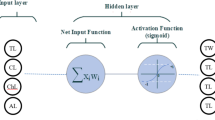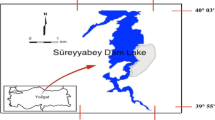Abstract
This study aims to compare the growth estimation of narrow-clawed crayfish (Astacus leptodactylus Eschscholtz, 1823) obtained from two methods which are length-weight relations and Artificial Neural Networks (ANNs) from Hirfanlı Dam Lake in 2013 and 2014. The growth estimation of 325 crayfish was carried out with both methods and the obtained results were compared. Then, the estimated values found via both methods were examined. Correlation coefficient (r), sum square error (SSE), mean absolute percentage error performance criteria (MAPE) were used for comparison of artificial neural network and linear regression models goodness of fit. The results of the current study show that compared to linear regression models, ANNs is a superior estimation tool. Thus, as an outcome of the present study, ANNs can be considered as a more efficient method especially in the growth estimation of the species in biological systems. Another outcome of this study is that crayfish of Hirfanlı Dam Lake well accommodates itself to the ecologic features of the environment and so its growth features are similar to the values of other water systems.
Similar content being viewed by others
References
Atar H.H. & Seçer S. 2003. Width/length-weight relationships of the blue crab (Callinectes sapidus Rathbun 1896) population living in Beymelek Lagoon Lake. Turk. J. Vet. Anim. Sci. 27 (2): 443–447.
Balık S., Ustaoğlu M.R., Sarı H.M. & Berber S. 2005. Determination of traits some growth and morphometric of crayfish (Astacus leptodactylus Eschscholtz, 1823) at Demirköprü Dam Lake (Manisa). Ege J. Fish. Aquat. Sci. 22 (1-2): 83–89. DOI: https://doi.org/10.12714/egejfas.2005.22.1.5000156891
Benzer S. & Benzer R. 2016. Evaluation of growth in pike (Esox lucius L., 1758) using traditional methods and artificial neural networks. Appl. Ecol. Environ. Res. 14 (2): 543–554. DOI: https://doi.org/10.15666/aeer/1402_543554
Benzer S., Benzer R. & Gül A. 2016. Artificial Neural Network applications for biological systems: The case study of Pseudo-rasbora parva. Chapter 5, pp. 49–58. In: Efe R., Matchavariani L., Yaldir A. & Lévai L. (eds), Developments in Science and Engineering, St. Kliment Ohridski University Press, Sofia, 769 pp. ISBN: 978-954-07-4137-6
Benzer S., Karasu Benli Ç. & Benzer R. 2015. The comparison of growth with length-weight relation and artificial neural networks of crayfish, Astacus leptodactylus, in Mogan Lake. J. Black Sea Mediter. Environ. 21 (2): 208–223.
Berber S. & Balık S. 2006. Determination of traits some growth and morphometric of crayfish (Astacus leptodactylus Eschscholtz, 1823) at Manyas Lake (Balı kesir). Ege J. Fish. Aquat. Sci. 23 (1–2): 83–91. DOI: https://doi.org/10.12714/egejfas.2006.23.1.5000156695
Berber S. & Balık S. 2009. The length-weight relationships, and meat yield of crayfish (Astacus leptodactylus Eschcholtz, 1823) population in Apolyont Lake (Bursa, Turkey). J. Fish. Sci. 3 (2): 86–99. DOI: https://doi.org/10.3153/jfscom.2009012
Brosse S., Guegan J., Tourenq J. & Lek S. 1999. The use of artificial neural networks to assess fish abundance and spatial occupancy in the littoral zone of a mesotrophic lake. Ecol. Modell. 120 (2-3): 299–311. DOI: https://doi.org/10.1016/S0304-3800(99)00110-6
Deniz T.B., Aydın C. & Ates C. 2013. A study on some morphological characteristics of Astacus leptodactylus (Eschscholtz 1823) in seven different inland waters in Turkey. J. Black Sea Mediter. Environ. 19 (2): 190–205.
DSİ. 1968. Limnological survey report of Hirfanli Dam Lake. Ankara, 216 pp.
Ekici B.B. & Aksoy U.T. 1993. Prediction of building energy consumption by using artificial neural networks. Advances in Engineering Software 40 (5): 356–362. DOI: https://doi.org/10.1016/j.advengsoft.2008.05.003
Evans J.D. 1996. Straightforward Statistics for the Behavioral Sciences. Pacific Grove, CA: Brooks/Cole Publishing, 600 pp. ISBN: 0534231004, 9780534231002
Füreder L., Oberkofler B., Hanel R., Leiter J. & Thaler B. 2003. The freshwater crayfish Austropotamobius pallipes in South Tyrol: Heritage species and bioindicator. [l’écrevisse Austropotamobius pallipes dans le Tyrol du Sud: espèce patrimoniale et bioindicateur]. Bull. Fr. Pêche Piscic. 370-371: 79–95. DOI: https://doi.org/10.1051/kmae:2003005
Gentry T.W., Wiliamowski B.M. & Weatherford L.R. 1995. A comparison of traditional forecasting techniques and neural networks, pp. 765–770. In: Dagli C.H., Akay M., Chen C.L.P., Fernández B.R. & Ghosh J. (eds), Intelligent Engineering Systems Through Artificial Neural Networks Vol. 5, Fuzzy Logic and Evolutionary Programming, American Society of Mechanical Engineers (ASME), 1056 pp. ISBN-10: 0791800482
Gillet C. & Laurent P.J. 1995. Tail length variations among noble crayfish (Astacus astacus (L)) populations. Freshwater Crayfish 10: 31–36.
Hald A. 1952. Statistical Theory with Engineering Applications. Wiley, New York, 783 pp. ISBN-10: 0471340561
Harlioğlu M.M. 1999. The relationships between length—weight, and meat yield of freshwater crayfish, Astacus leptodactylus Eschscholtz, in the Ağın Region of Keban Dam Lake. Turk. J. Zool. 23 (EK3): 949–958.
Harlioğlu M.M. & Harlioğlu A.G. 2005. Eğirdir, İznik Gölleri ve Hirfanlı Baraj Gölünden Avlanan Tatlı Su İstakozu Astacus leptodactylus (Eschscholtz, 1823)’un Morfometrik Analizleri ile Et Verimlerinin Karşılaştırılması [The comparison of morphometric analysis and meat yield contents of freshwater crayfish, Astacus leptodactylus (Esch 1823) caught from İznik, Eğirdir Lakes and Hirfanlı Dam Lake]. Fırat Üniversitesi Mühendislik Fakültesi Dergisi [Science and Engineering Journal of Fırat University] 17 (2): 412–423.
Haykin S. 1999. Neural Networks: A Comprehensive Foundation, Perenctice Hall, New Jersey, 842 pp. ISBN: 0132733501, 9780132733502
Hopgood A.A. 2000. Intelligent Systems for Engineers and Scientists. 2nd edn. CRC Press, Forida, 488 pp. ISBN: 0-8493-0456-3
Krenker A., Bešter J. & Kos A. 2011. Introduction to the Artificial Neural Networks, pp. 3–18. DOI: https://doi.org/10.5772/15751. In: Suzuki K. (ed.), Artificial Neural Networks - Methodological Advances and Biomedical Applications, 362 pp. ISBN: 978-953-307-243-2
Lewis C.D. 1982. Industrial and Business Forecasting Methods. London: Butterworths, 144 pp. DOI: https://doi.org/10.1002/for.3980020210
Lindqvist O.V. & Lahti E. 1983. On the sexual dimorphism and condition index in the crayfish Astacus astacus L. in Finland. Freshwater Crayfish 5: 3–11.
Maravelias C.D., Haralabous J. & Papaconstantinou C. 2003. Predicting demersal fish species distributions in the Mediterranean Sea using artificial neural networks. Mar. Ecol. Prog. Ser. 255: 249–258. DOI: https://doi.org/10.3354/meps255249
Mastrorillo S., Lek S., Dauba F. & Belaud A. 1997. The use of artificial neural networks to predict the presence of small-bodied fish in river. Freshwater Biol. 38 (2): 237–246. DOI: https://doi.org/10.1046/j.1365-2427.1997.00209.x
Mendes B., Fonseca P. & Campos A. 2004. Weight-length relationships for 46 fish species of the Portuguese west coast. J. Appl. Ichthyol. 20 (5): 355–361. DOI: https://doi.org/10.1111/j.1439-0426.2004.00559.x
Morato T., Afonso P., Lourinho P., Barreiros J.P., Santos R.S. & Nash R.D.M. 2001. Length—weight relationships for 21 coastal fish species of the Azores, north-eastern Atlantic. Fish. Res. 50 (3): 297–302. DOI: https://doi.org/10.1016/S0165-7836(00)00215-0
Obach M., Wagner R., Werner H. & Schmidt H.H. 2001. Modelling population dynamics of aquatic insects with artificial neural networks. Ecol. Modell. 146 (1-3): 207–217. DOI: https://doi.org/10.1016/S0304-3800(01)00307-6
Panofsky H.A. & Brier G.W. 1968. Some Applications of Statistics to Meteorology. Pennsylvania State University, University Park, 224 pp.
Park Y.S., Verdonschot P.F.M., Chon T.S. & Lek S. 2003. Patterning and predicting aquatic macro invertabrate diversities using artificial neural network. Water Res. 37 (8): 1749–1758. DOI: https://doi.org/10.1016/S0043-1354(02)00557-2
Primavera J.H., Parado-Estepa F.D. & Lebata J.L. 1998. Morphometric relationship of length and weight of giant tiger prawn Penaeus monodon according to life stage, sex and source. Aquaculture 164 (1-4): 67–75. DOI: https://doi.org/10.1016/S0044-8486(98)00177-X
Rhodes C.P. & Holdich D.M. 1979. On size and sexual dimorphism in Austropotamobius pallipes (Lereboullet) - A step in assessing the commercial exploitation potential of the native British freshwater crayfish. Aquaculture 17 (4): 345–358. DOI: https://doi.org/10.1016/0044-8486(79)90089-9
Ricker W.E. 1973. Linear regressions in fishery research. J. Fish. Res. Board Can. 30 (3): 409–434. DOI: https://doi.org/10.1139/f73-072
Romaire R.P., Forester J.S. & Avault J.W. 1977. Length-weight relationships of two commercially important crayfishes of the genus Procambarus. Freshwater Crayfish 3: 463–470.
Rumelhart D.E., Hinton G.E. & Williams R.J. 1986. Learning internal representations by error propagation, pp. 318–362. In: Parallel Distributed Processing. Explorations in the Mi-crostructure of Cognition, Vol. 1, MIT Press, Cambridge, MA, USA, 567 pp. ISBN: 0-262-18120-7
Sinovcic G., Franicevic M., Zorica B. & Ciles-Kec V 2004. Length—weight and length—length relationships for 10 pelagic fish species from the Adriatic Sea (Croatia). J. Appl. Ichthyol. 20 (2): 156–158. DOI: https://doi.org/10.1046/j.1439-0426.2003.00519.x
Skurdal J. & Qvenild T. 1986. Growth, maturity, and fecundity of Astacus astacus in lake Steinfjorden, S.E. Norway. Freshwater Crayfish 6: 182–186.
Souty-Grosset C, Holdrich D.M., Noel P.Y., Reynolds J.D. & Haffner P. (eds). 2006. Atlas of Crayfish in Europe. Publications Scientifiques du Museum national d’Histoire naturelle, Paris, Patrimoines naturels Vol. 64, 187 pp. ISBN: 978-2-85653-579-0
Sun L., Xiao H., Li S. & Yang D. 2009. Forecasting fish stock recruitment and planning optimal harvesting strategies by using neural network. Journal of Computers 4 (11): 1075–1082. DOI: https://doi.org/10.4304/jcp.4.11.1075-1082
Suryanarayana I., Braibanti A., Rao R.S., Ramamc V.A., Su-darsan D. & Rao G.N. 2008. Neural networks in fisheries research. Fish Res. 92 (2-3): 115–139. DOI: https://doi.org/10.1016/j.fishres.2008.01.012
Tesch F.W. 1971. Age and growth, p. 99–130. In: Ricker W.E. (ed.), Methods for Assessment of Fish Production in Fresh Waters, 2nd edn., Blackwell Scientific Publications, Oxford, 348 pp. ISBN-10: 0632084901
Tosunoğlu Z., Aydın C., Özaydın O. & Leblebici S. 2007. Trawl codend mesh selectivity of braided PE material for Parapenaeus longirostris (Lucas, 1846) (Decapoda, Penaeidae). Crustaceana 80 (9): 1087–1094. DOI: https://doi.org/10.1163/156854007782008649
Tureli Bilen C., Kokcu P. & Ibrikci T. 2011. Application of artificial neural networks (ANNs) for weight predictions of blue crabs (Callinectes sapidus Rathbun, 1896) using predictor variables. Medit. Mar. Sci. 12 (2): 439–446. DOI: https://doi.org/10.12681/mms.43
Witt S.F. & Witt C.A. 1992. Modeling and Forecasting Demand in Tourism. Londra: Academic Press, 195 pp. ISBN: 0-127-60740-4
Yanez E., Plaza F., Gutierrezestrada J.C., Rodriquez N., Barbieri M.A., Pulido-Calvo I. & Borquez C. 2010. Anchovy (Engraulis ringens) and sardine (Sardinops sagax) abundance forecast off northern Chile: A multivariate ecosystem neural network approach. Oceanography 87: 242–250. DOI: https://doi.org/10.1016/j.pocean.2010.09.015
Author information
Authors and Affiliations
Corresponding author
Rights and permissions
About this article
Cite this article
Benzer, S., Benzer, R. & Günal, A.Ç. Artificial Neural Networks approach in morphometric analysis of crayfish (Astacus leptodactylus) in Hirfanlı Dam Lake. Biologia 72, 527–535 (2017). https://doi.org/10.1515/biolog-2017-0052
Received:
Accepted:
Published:
Issue Date:
DOI: https://doi.org/10.1515/biolog-2017-0052




